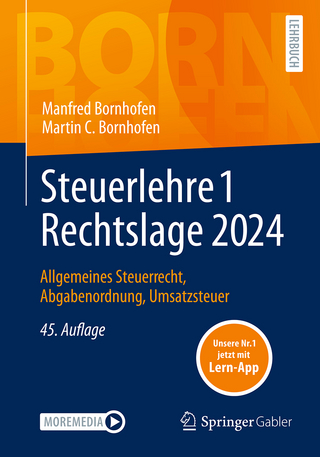
Financial Services Marketing
Routledge (Verlag)
978-1-138-68451-5 (ISBN)
- Titel erscheint in neuer Auflage
- Artikel merken
This fully updated and revised edition features:
An expanded section on regulation which has international reach and addresses the post-Brexit world
Greatly expanded coverage of digital marketing at both the strategic and tactical levels
New material on how to improve a company’s trustworthiness and safeguard a culture that is customer-focussed
New examples, vignettes and case studies that showcase best practice from around the world
B2B and B2C marketing
Upgraded PowerPoint support on the companion website
Financial Services Marketing 3e will be hugely beneficial to academic students of marketing and finance, as well as essential reading to those industry-based and studying for professional qualifications.
Christine Ennew OBE is Professor of Marketing and Provost at the University of Warwick. She has been actively involved in financial services research for most of her academic career. She has published some 100 articles in refereed journals, presented over 60 refereed conference papers and produced 4 books. Nigel Waite is a Director of 3R Insights, an advisory organisation that helps boards of directors to deliver good outcomes to customers of financial services companies. He is also Honorary Professor of Marketing at Nottingham University Business School. Róisín Waite is Head of Group Digital at Barclays. Róisín was one of the first to graduate from the UKs first MSc in Digital Marketing Communications.
Contents
Acknowledgements
Introduction
PART I: Context and Strategy
Chapter 1: The Role, Contribution and Context of Financial Services
1.1 Introduction
1.2 Economic Development
1.3 Government Welfare Context
1.4 Lifetime Income Smoothing
1.5 The Management of Risk
1.6 Poverty and Financial Exclusion
1.7 Mutual and Proprietary Supply
1.8 Regulation of Financial Services
1.9 A New Philosophy and Approach to Regulation
1.9.1 On the role of financial markets
1.9.2 Three major regulatory challenges
1.9.3 UK regulatory reform – a new regulatory architecture, approach, and philosophy
1.9.4 Regulatory philosophy
1.9.5 European regulatory reforms
1.9.6 Potential impact of Brexit
1.9.7 Future challenges
1.10 Summary and conclusions
Case Study 1 Micro-insurance
Chapter 2: The Financial Services Marketplace: Structures, Products and Participants
2.1 Introduction
2.2 Some Historical Perspectives
2.3 The Geography of Supply
2.4 Financial Advice
2.6 Banking and Money Transmission
2.7 Lending and Credit
2.8 Saving and Investing
2.9. Life Insurance Products
2.9.1 Life Insurance
2.9.2 Health Insurance
2.9.3 Annuities
2.10 General Insurance
2.11 Summary and conclusions
Case Study 2: Police Mutual Assurance Society Limited (Police Mutual) *
Chapter 3: Marketing Financial Services: An Overview
3.1 Introduction
3.2 Defining Financial Services *
3.3 The Differences Between Goods and Services
3.4 The Distinctive Characteristics of Financial Service
3.4.1 Intangibility *
3.4.2 Inseparability
3.4.3 Perishability
3.4.4 Heterogeneity *
3.4.5 Fiduciary responsibility
3.4.6 Contingent Consumption
3.4.7 Duration of Consumption
3.5 The Marketing Challenge
3.6 Classifying Services
3.7 Summary and Conclusions
Case Study 3: Aktif Bank - Aktif Online
Chapter 4: Strategic Development and Marketing Planning
Objectives
4.1 Introduction
4.2 Strategic Marketing
4.3 Developing a Strategic Marketing Plan
4.3.2 Situation Analysis
4.3.3 Marketing Objectives
4.3.4 Marketing Strategy
4.3.5 Market Specific Strategy
4.3.6 Implementation
4.4 Tools for Strategy Development *
4.4.1 Growth Strategies
4.4.2 Selecting the Product Portfolio
4.4.3 Competitive Advantage
4.5 Summary and Conclusions
Case Study 4: Retail banking in China
Chapter 5: Analysing the Marketing Environment
5.1 Introduction *
5.2 The Marketing Environment
5.3 The Macro-Environment
5.3.1 The Political Environment
5.3.2 The Economic Environment
5.3.3 The Social Environment
5.3.4 The Technological Environment
5.4 The Market Environment
5.5 The Internal Environment
5.5.1 Resources
5.5.2 Competences/capabilities
5.5.3 Auditing the Internal Environment
5.6 Evaluating Developments in the Marketing Environment
5.7 Conclusions
Case Study 5: Private Banking in China
Chapter 6: Understanding the Financial Services Consumer
6.1 Introduction
6.2 Consumer Choice and Financial Services
6.2.1 Problem Recognition
6.2.2 Information Search
6.2.3 Evaluation of Alternatives
6.2.4 Purchase Decision
6.2.6 Summary
6.3 Consumer Buying Behaviour in Financial Services
6.4 Marketing Responses *
6.5 Researching Financial Services Customers
6.5.1 Processes and Outputs
6.5.2 Research for product and service development:
6.5.3 Research for brand and communications:
6.5.4 Stakeholder understanding
6.5.5 Market Understanding
6.5.6 Thought leadership and research for PR
6.5.7 Social Media monitoring
6.5.8 Qualitative and Quantitative methods, techniques and tools
6.5.8 Ethical Issues
6.6 Conclusions
Case study 6: Behavioural Economics and the Financial Services Consumer
Chapter 7: Segmentation Targeting and Positioning
7.1 Introduction
7.2 The Benefits of Segmentation and Targeting
7.3 Successful Segmentation
7.4 Approaches to Segmenting Consumer Markets
7.4.1 Customer Characteristics: Customer Orientated Segmentation
7.4.2 Customer Needs and Behaviours: Product Orientated Segmentation
7.5 Approaches to Segmenting Business-to-Business Markets
7.6 Segmentation in a Digital World
7.7 Targeting Strategies
7.7.1 Undifferentiated Targeting
7.7.2 Differentiated Targeting
7.7.3 Focused Segmentation
7.7.4 Customised Targeting
7.8 Positioning Products and Organisations
7.8.1 Perceptual Mapping
7.9 Repositioning
7.10 Summary and Conclusions
Case Study 7: Entrepreneurial Spark powered by Natwest
Chapter 8: Internationalisation Strategies for Financial Services
8.1 Introduction
8.2 Internationalisation and the Characteristics of Financial Services
8.3 The Drivers of Internationalisation
8.3.1 Firm-Specific Drivers of Internationalisation
8.3.2 Macro level Drivers of Internationalisation
8.3.2 The Extent of Internationalisation in Financial Services Sector
8.4 Globalisation Strategies
8.4.1 International Strategies
8.4.2 Global Strategies
8.4.3 Multi-Domestic Strategies
8.4.4 Trans-National Strategies
8.5 Strategy Selection and Implementation
8.5.1 Which markets to enter
8.5.1 Method of market entry
8.5.1 How to market in international markets
8.6 Summary and conclusions
Case Study 8: Prudential
Part II
Chapter 9: Customer Acquisition and the Marketing Mix
9.1 Introduction
9.2 Short Term Marketing Planning
9.3 The Role of the Financial Services Marketing Mix
9.4 The Financial Services Marketing Mix: Key Issues
9.4.1 Process
9.4.2 Physical Evidence
9.4.3 People
9.5 Customer Acquisition and the Financial Services Marketing Mix
9.6 Digital Marketing and Customer Acquisition
9.6.1 Context and Convenience
9.6.2 Segmentation and Targeting
9.6.3 Managing the Process
9.6.4 Migrants, Natives and Social Media
9.6.5 Integrating On and Off-Line
9.6.6 Digital organisational structure
9.7 Customer Acquisition and Ethical Behaviour
9.8 Summary and Conclusions
Case study 9: CIC Insurance, Kenya – A marketing Mix for Micro Insurance
Chapter 10: Product and Consumer needs
10.1 Introduction
10.2 The Concept of the Service Product
10.2.1 What Customers Want
10.2.2 What organisations can provide
10.3 Islamic Financial Instruments
10.4 Influences on Product Management
10.5 Managing Existing Product Lines
10.5.1 Product Attributes
10.5.2 Product Modification/Product Development
10.6 New Product Development
10.6.1 Major innovations:
10.7 Conclusions
Case Study 10: What is a bond
Chapter 11 Communication and Promotion
11.1 Introduction
11.2 Principles of Communication
11.3 Planning a Promotional Campaign
11.3.1 Stages in Communications Planning
11.3.2 Integrated Marketing Communications
11.4 Forms of Communication
11.4.1 Advertising
11.4.2 Personal Selling
11.4.3 Publicity/Public Relations
11.4.4 Sales Promotion
11.4.5 Direct Marketing
11.5 The digital effect
11.6. Summary and Conclusions
Case Study 11: Direct Line Insurance
Chapter 12: Price and Cost to the Consumer
12.1 Introduction
12.2 The Role and Characteristics of Price
12.3 The Challenges of Pricing for Providers of Financial Services
12.4 Methods Used for Determining Price
12.1.1 Cost-Based Pricing
12.4.2 Competition-Based Pricing
12.4.3 Marketing-oriented Pricing
12.5 Price Differentiation and Preferred Lives
12.6 Price Determination
12.7 Pricing Strategy and Promotional Pricing
12.8 Impact of digital marketing on charges and pricing
12.9 Summary and Conclusions
Case Study 12: Co-op Insurance: Using technology to deliver lower premiums to young drivers
Chapter 13: Consumer Convenience and Distribution
13.1 Introduction
13.2 Channels of Distribution: Distinguishing Features
13.3 Distribution Methods and Models
13.3.1 Direct versus Indirect Distribution
13.3.1 Whether Products are Bought or Sold
13.4 Distribution Channels
13.5 Summary and Conclusions
Case Study 13 The Aviva Financial Adviser Academy
Chapter 14: Customer Relationship Management: Principles and Practice
14.1 Introduction
14.2 Drivers of Change
14.3 Customer Persistency – Acquire the Right Customers
Acquisition process characteristics
14.4 Retaining the Right Customers
14.5 Customer Retention Strategies
Advocate
14.7 Lifetime Customer Value
14.8 Digital Marketing and its Impact on CRM
14.8.1 Context
14.8.2 Customer Data Management and Analytics
14.8.3 Integrating On and Off-line for Effective CRM
14.8.4 Personalisation
14.8.5 Social CRM
14.8.6 Digital tools - CRM systems
14.8.7 Data Privacy and Cookies
14.9 Relationship Marketing in Specific Contexts
14.9.1 Relationship Marketing and the Role of Intermediaries
14.9.2 Relationship Marketing: Some International Perspectives
14.10 Summary and Conclusions
Case 14: The American Express International Loyalty Programme
Chapter 15: Service Delivery and Service Quality
15.1 Introduction
15.3 The Service Profit Chain
15.3 Defining Service Quality
15.4 Models of Service Quality
15.4.1 The Nordic Perspective on Service Quality
15.4.2 The North American Perspective on Service Quality
15.4.3 Integrating the Nordic and the North American Perspectives
15.5 The Gap Model of Service Quality.
15.6 The Outcomes of Service Quality
15.7 Service Failure and Recovery
15.8 Summary and Conclusions
Case Study 15: Nationwide Building Society – Nationwide/KPMG Nunwood Service Tracker
Chapter 16: Satisfaction, Value, Trust and Fairness in Customer Relationships
16.1 Introduction
16.2 Consumer Evaluations: Value and Satisfaction
16.2.1 Customer Value
16.2.2 Customer Satisfaction
16.3 Managing Customer Expectations
16.4 The Measurement of Satisfaction
16.4.1 Customer Satisfaction
16.4.2 Employee Satisfaction
16.5 Consumer Trust
16.5.1 The Meaning of Trust *
16.5.2 Measuring Trust: The Trust Index
16.5.3 Trustworthiness
16.5.4 How Trust is Won, Retained and Lost
16.5.5 Trust in a digital world
16.6 Treating Customers Fairly
16.7 Summary and Conclusions
Case Study 16: NTUC Income: the Orange Revolution
Chapter 17: Marketing: Culture, Challenges and Social Responsibility
17.1 Introduction
17.2 People and Culture
17.3 Product Considerations
17.4 Pricing and Value
17.5 Advertising and Promotion
17.6 Distribution and Access
17.7 Processes
17.8 Evaluating Marketing Performance
17.9 Corporate Social Responsibility (CSR)
17.10 Towards a Sustainable Future
17.11 Summary and Conclusions
Case Study 17: Consumer Perceptions of CEOs and Directors of Financial Services Companies
| Erscheinungsdatum | 30.01.2018 |
|---|---|
| Zusatzinfo | 35 Tables, black and white; 99 Line drawings, black and white; 14 Halftones, black and white; 113 Illustrations, black and white |
| Verlagsort | London |
| Sprache | englisch |
| Maße | 174 x 246 mm |
| Gewicht | 1156 g |
| Themenwelt | Wirtschaft ► Betriebswirtschaft / Management ► Finanzierung |
| Wirtschaft ► Betriebswirtschaft / Management ► Marketing / Vertrieb | |
| Wirtschaft ► Volkswirtschaftslehre ► Finanzwissenschaft | |
| ISBN-10 | 1-138-68451-1 / 1138684511 |
| ISBN-13 | 978-1-138-68451-5 / 9781138684515 |
| Zustand | Neuware |
| Haben Sie eine Frage zum Produkt? |
aus dem Bereich



